
Last Updated 13 Mar 2022 Difficulty level : Moderate
Section Links:
Introduction
Run multiple versions of Office with the same bitness
Install Access runtime and full versions of Access
Install mixed bitness Office versions
Conclusions
Further Reading

1. Introduction Return To Top
Although not recommended by Microsoft, it is possible to install more than one version of Office.
In fact, as a developer, there are good reasons for doing so in order to test how your apps will work for your clients before distribution.
For example, you may need to test your apps in:
• different versions of Access
• both 32-bit and 64-bit Access
• both runtime and full version of Access
As a general rule, you should ALWAYS develop in the earliest version of Access used by your clients.
If you need to test in different versions, you can either:
• install different versions on virtual machines (VMs)
• install different versions side-by-side on the same workstation
Using virtual machines is often the best approach as it avoids configuration issues that you may experience with side-by-side installations.
However, virtual machines can require a lot of RAM and performance can be poor unless you have a powerful computer.
This article discusses ways of running side-by side installations successfully

2. Run two or more versions of Office with the same bitness Return To Top
For many years, I have run both 32-bit Office 2010 and 32-bit Office 365 on my main development machine.
For a long time before that I ran Office 2003 together with 32-bit Office 2010
To do this successfully, you should ALWAYS install the earlier 32-bit Office version first in e.g.
• C:\Program Files\Microsoft Office (if using 32-bit Windows)
• C:\Program Files (x86)\Microsoft Office (if using 64-bit Windows)
The later version should be installed in a separate folder named according to the Office version.
For example, Office 2013 is version 15 so it should be installed in e.g. C:\Program Files\Microsoft Office 15
You can install dual versions of each Office app such as Access/Excel/Word etc with ONE exception.
Only ONE version of Outlook can be installed. I recommend this should ALWAYS be the newer version
NOTE:
Exactly the same rules apply if you want to install two or more 64-bit versions of Office under 64-bit Windows
Once you have installed two or more versions, the default Office version will be the last (newest) version installed.
This means that, for example, if you double click an Access app in Windows File Explorer, it will open in the newest version of Access.
In order to open an Access app in an older version, you can do any of the following:
a) Start the older version of Access, then select the file you want to open
b) Right click the file then click Open With and select the version you require
c) Change the default app in Windows settings – this will update the various registry settings associated with the Access file type e.g. ACCDB / ACCDE
IMPORTANT:
If you open the same Access app in the newer version e.g. Access 365 then later open it in an earlier version such as Access 2010, Office will need to be 'reconfigured'.
A dialog box similar to that below will be shown several times whilst the reconfiguration is carried out

This may take 2-3 minutes during which various registry settings are updated.
To save time, try to avoid doing this as far as possible.

3. Install Access runtime together with full versions of Access Return To Top
Users can install runtime whether or not Office and Access are installed.
If a full copy of Access is already installed, the Access runtime must be a different version and is obtained as a separate download.
For example, you can install 32-bit Access 2013 runtime together with 32-bit Access 2010.
However, you may have problems if the different versions employ different installation technologies:
• Click-to-Run (C2R) used by Office 2019/2021/365 or Microsoft Installation files (MSI) used by Office 2010.
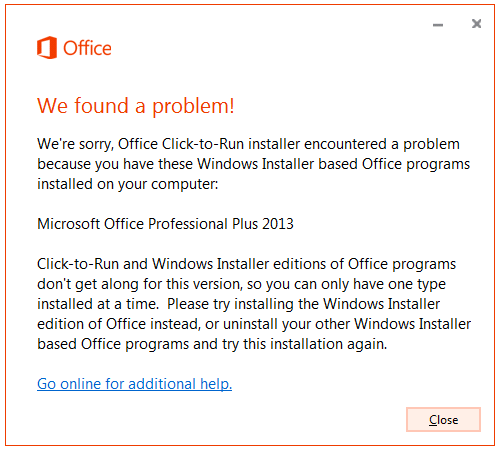
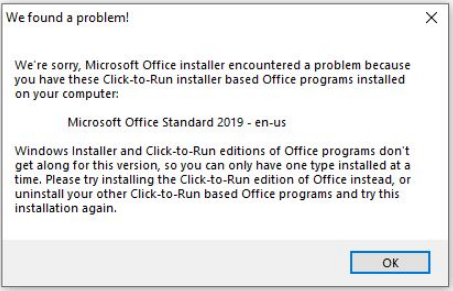
Just to add to possible confusion, Office 2013 & 2016 were available in both C2R & MSI variants.
So, for example, the Microsoft 365 Access Runtime is not compatible with Office products installed with Windows Installer.
For more information, see Office installed with Click-to-Run and Windows Installer on same computer isn't supported.
NOTE:
This issue also applies to standalone Office applications such as Visio, Project, Skype for Business, or OneDrive for Business.

4. Install mixed bitness versions of Office Return To Top
For many years, most developers (including me!) have been repeating the same mantra about not being able to install mixed bitnesses of Office in any circumstances.
Indeed, attempts to do so often fail with messages such as these:
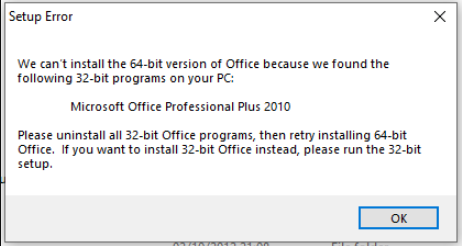
You can't install 64-bit Office on a workstation with 32-bit Office
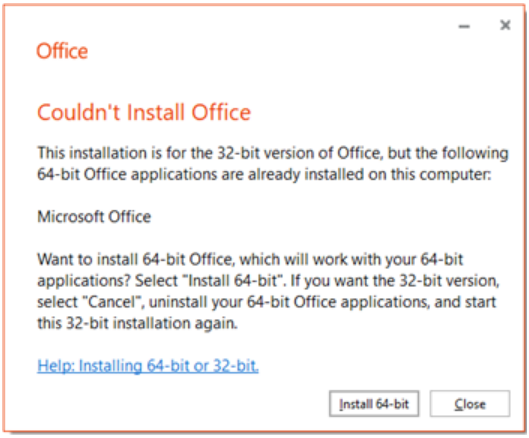
You can't install 32-bit Office on a workstation with 64-bit Office
So it can’t be done . . .right? Well actually no . . . sometimes it can be done!
Some time ago, I had read an article by Albert Kallal from 2016: Can Access 2013 Runtime 32bit coexist with Office 64bit in which he suggested that 64-bit Runtime and 32-bit Access could both be installed on the same workstation. At the time I was very sceptical about this claim.
However, back in July 2021, I finally decided to put this to the test and found it to be partly true . . .
First of all, I tried installing Access 2013 64-bit Runtime on a machine with 32-bit Office 2010 installed. It failed with exactly the same message as I showed above
I then re-tested with Access 2013 32-bit Runtime on another workstation with Office 365 64-bit. To my surprise, that installed perfectly.
So I tried again, this time installing Office 2010 32-bit on the same machine with Office 365 64-bit. Once again, it worked!
As a result, I decided to do some more systematic tests.
First of all, I tried installing a 64-bit version of Access AFTER a 32-bit version. With one exception, this failed each time.

I then repeated the tests but this time attempting to install a 32-bit version AFTER a 64-bit version
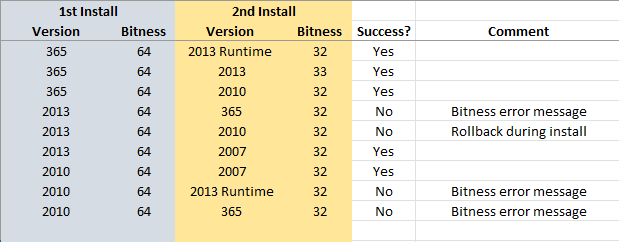
I was very surprised to find that many (but not all) of the mixed bitness installations were successful
SUMMARY
a) Trying to install a 64-bit version after a 32-bit version failed EVERY time with the exception of 2013 Runtime 64-bit and 365 32-bit
b) Installing an older version of 32-bit Office after a newer version of 64-bit Office USUALLY worked though I repeatedly got an error with 2010 32-bit on top of 2013 64-bit
c) Installing a newer version of Office after an older version of Office failed with a bitness error.
That applies whether the first install is 32 or 64-bit (and the opposite for the second install)

5. Conclusions Return To Top
If you have 32-bit Office installed, you CANNOT install 64-bit Office components even if these are a different version or Access runtime (unless you use a VM).
However, If you have 64-bit Office installed, you CAN also then install 32-bit Office or Access runtime as long as it is a different version. No VM required.
In every case where a mixed bitness installation was successful, each version of Access worked without any additional issues
So mixed bitness installs can indeed be done in certain situations.
The most likely to work is a new 64-bit version followed by an older 32-bit version
One obvious benefit of doing this is the ability to create both 32-bit and 64-bit ACCDEs on the same workstation . . . albeit using different versions of Access
However, whether it is in general a good idea to do this in a different matter!
NOTE:
I am not recommending that you should install mixed bitnesses . . . but in certain circumstances you can do so, and it works without any issues.

6. Further Reading Return To Top
64-bit and 32-bit on the same machine
Can Access 2013 Runtime 32bit coexist with Office 64bit
Install Access database runtime
Migrate Access DB to browser-based on local network
Side-by-Side Installs of 32-bit and 64-bit Versions of Access
Colin Riddington Mendip Data Systems Last Updated 13 Mar 2022
